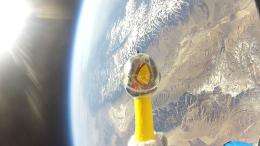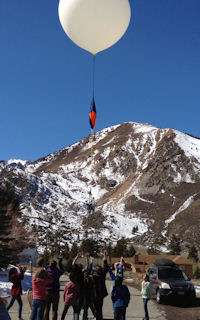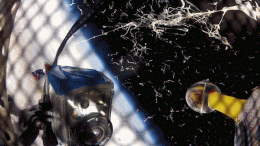Rubber chicken flies into solar radiation storm

Last month, when the sun unleashed the most intense radiation storm since 2003, peppering satellites with charged particles and igniting strong auroras around both poles, a group of high school students in Bishop, California, knew just what to do.
They launched a rubber chicken.
The students inflated a helium balloon and used it to send the fowl, named "Camilla," to an altitude of 120,000 ft where she was exposed to high-energy solar protons at point blank range.
"We equipped Camilla with sensors to measure the radiation," says Sam Johnson (age 16) of Bishop Union High School's Earth to Sky student group1. "At the apex of our flight, the payload was above 99% of Earth's atmosphere."
Launching a rubber chicken into a solar storm might sound strange, but the students had good reason: They're doing an astrobiology project.
"Later this year, we plan to launch a species of microbes to find out if they can live at the edge of space," explains team member Rachel Molina (age 17). "This was a reconnaissance flight."
Many space enthusiasts are already familiar with Camilla. She's the mascot of NASA's Solar Dynamics Observatory. With help from her keeper, Romeo Durscher of Stanford University, Camilla corresponds with more than 20,000 followers on Twitter, Facebook, and Google+, filling them in on the latest results from NASA's heliophysics missions.
"Camilla's trip to the stratosphere2 gave us a chance to talk to thousands of people about the radiation storm," says Durscher.

On the outside of her space suit (knitted by Cynthia Coer Butcher from Blue Springs, Missouri), Camilla wore a pair of radiation badges, the same kind medical technicians and nuclear workers wear to assess their dosages.
Camilla actually flew twice--once on March 3rd before the radiation storm and again on March 10th while the storm was in full swing. This would give the students a basis for comparison.

On March 3rd, during the calm before the storm, the Earth to Sky team assisted by a local class of 5th graders attached Camilla to the payload, inflated the balloon, and released the "stack" (balloon, parachute and payload) into a cloudless blue sky just before local noon.
"It was a beautiful lift-off," says Amelia Koske-Phillips (age 15), the team's payload manager and "launch boss."
During the two and a half hour flight, Camilla spent approximately 90 minutes in the stratosphere where temperatures (-40 to -60 C) and air pressures (1% sea level) are akin to those on the planet Mars. The balloon popped, as planned, at an altitude of about 40 km and Camilla parachuted safely back to Earth. The entire payload was recovered intact from a landing site in the Inyo Mountains.
The payload, a modified department store lunchbox, carried four cameras, a cryogenic thermometer, and two GPS trackers. Seven insects and two dozen sunflower seeds also rode along to test their response to near-space travel. The seeds were a variety known to gardeners as "Sunspot" (Helianthus annuus).
One week later, on March 10th, the storm was underway, and the students repeated the experiment.
Camilla flew into one of the strongest proton storms in years. The source of the radiation was sunspot AR1429, which unleashed more than 50 solar flares during the first two weeks of March. At the peak of the storm, from March 7th through 10th, charged particles hitting Earth's upper atmosphere deposited enough heat in only three days to power every residence in New York City for two years. At the moment of Camilla's launch on March 10th, Earth-orbiting satellites reported proton counts ~30,000 times normal.
"The profile of the second flight was almost identical to the first--perfect for our experiment," adds Johnson. "We recovered the payload from a landing site near Deep Springs, California."
The 5th grade assistants are now planting the sun flower seeds to see if radiated seeds produce flowers any different from seeds that stayed behind on Earth. They're also pinning the corpses of the insects—none survived—to a black "Foamboard of Death," a rare collection of bugs that have been to the edge of space.
Meanwhile, Camilla's radiation badges have been sent to a commercial laboratory for analysis.
The students say they are looking forward to the data and maybe—just maybe—sending Camilla back for more.
More information: www.facebook.com/NASA.Camilla.SDO
Source: Science@NASA




















